With the shrimp hobby exploding in the past few years, the number of selectively bred dwarf shrimp species has shot up. New varieties are always appearing, and our knowledge of keeping and breeding these inverts is ever-growing.
In need of shrimpspiration? We discuss 19 aquarium shrimp species. From extremely popular to quite uncommon and from beginner-proof to a little more challenging: there’s a shrimp for every aquarist!
Note: If you want to know more about general dwarf shrimp care, have a look at the article on keeping dwarf shrimp!
Red Cherry Shrimp (Neocaridina Davidi)
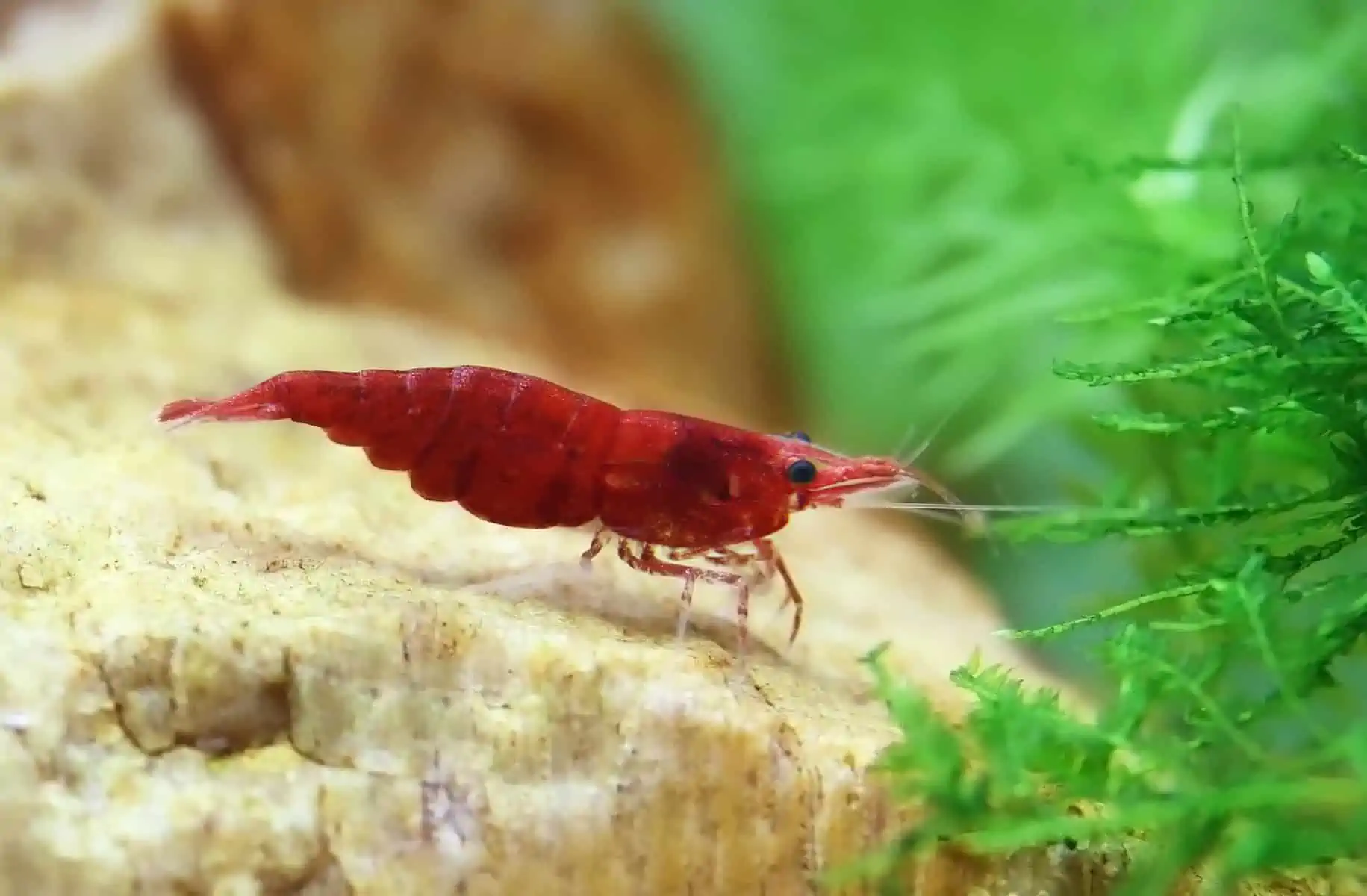
- Scientific Name: Neocaridina davidi var. red
- Care Level: Easy
- Size: 1.5 inch
- Minimum tank size: 5 gallons
- Temperature Range: 65 to 85°F/18 to 29.5°C
- Suggested pH: 6.3 to 8.0
Red Cherry Shrimp are one of the most popular species of freshwater aquarium shrimp, characterized by their bright colors and hardy nature.
Compared to other shrimp species, Red Cherries are considered easy to care for and can thrive in peaceful community tanks (as long as no aggressive tank mates are present!)
Red Cherry Shrimp do best when kept in a tank environment with temperatures between 77-81 °F/18-29.5 °C. Higher temperatures encourage faster breeding and growth but can be troublesome due to lower dissolved oxygen concentrations.
Lower temperatures discourage Red Cherry Shrimp from breeding and can be used to slow down the growth of large colonies.
Feeding Red Cherry Shrimp is usually quite easy. In fact, a large colony actually makes for a great clean-up crew. As an omnivorous species, Red Cherry Shrimp will feed on both algae and uneaten/leftover fish food.
If you plan to keep a shrimp-only tank, supplemental feeding is always a good idea. Glas Garten Shrimp Dinner is a pelleted shrimp food that should be appreciated by your Red Cherries.
Want to know more? You can find a full Red Cherry Shrimp care sheet here.
Blue Tiger Shrimp (Caridina cf. Cantonensis ‘Blue Tiger’)
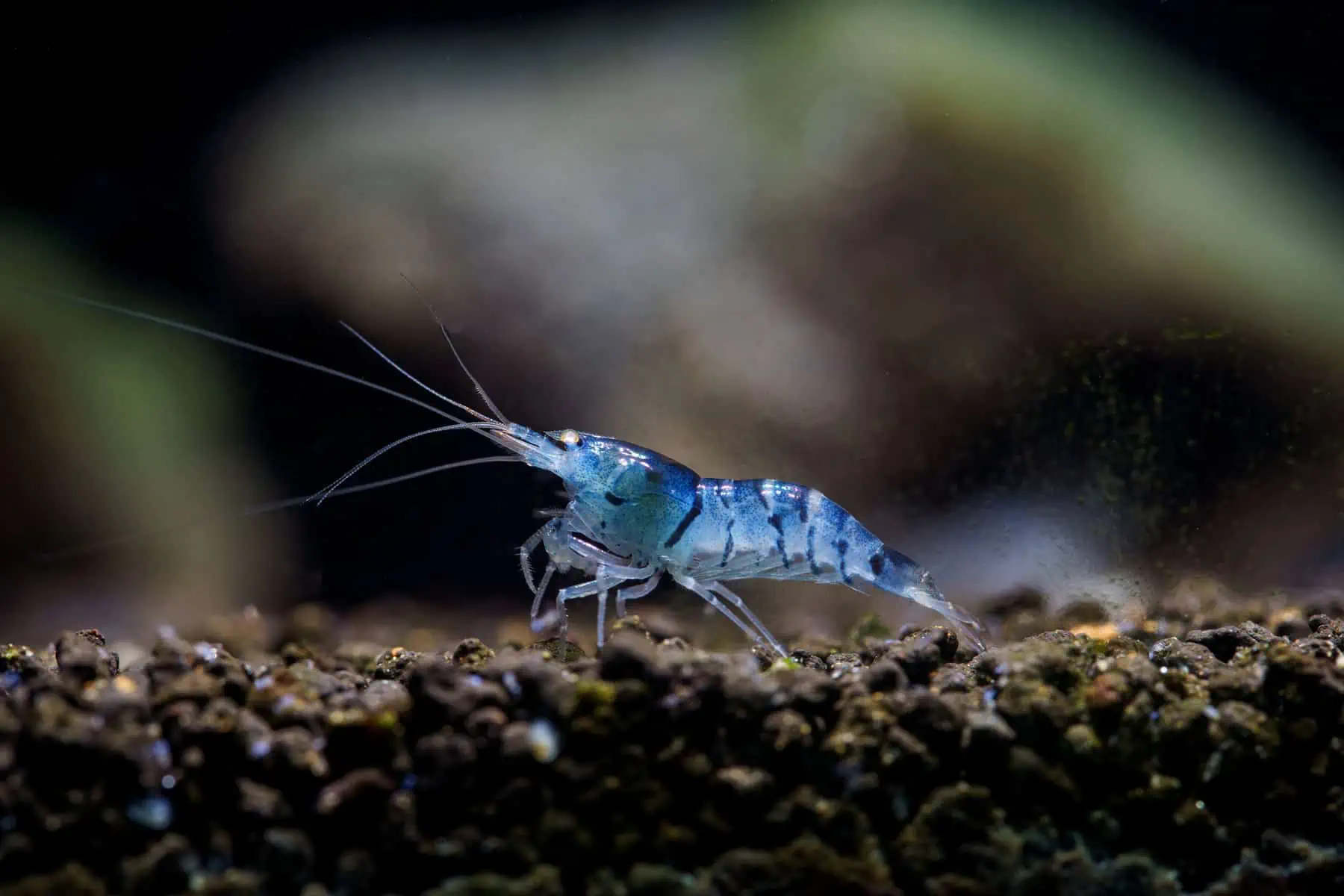
- Scientific Name: Caridina cf. cantonensis ‘Blue Tiger’
- Care Level: Moderate
- Size: 1.5 inches
- Minimum tank size: 5 gallons
- Temperature Range: 65 to 75°F/18 to 24°C
- Suggested pH: 6.0 to 7.5
Blue Tigers are a striking species of freshwater aquarium shrimp famous for their stunning, deep blue bodies and bright orange eyes.
Blue Tiger Shrimp are a species of Caridina cf. cantonensis, so their care requirements are very similar to many others on our list.
Blue Tiger Shrimp aren’t necessarily the easiest species to keep (that distinction goes to Cherry Shrimp), but they aren’t overly difficult. Like any fish or invertebrate, a cycled tank and good water quality are extremely important.
As long as you keep the water temperatures stable, pH within the acceptable range, and nitrates at a minimum, this stunning species should thrive in your aquarium. In addition, make sure to keep up with weekly/bi-weekly water changes!
As with other Cantonensis species, Blue Tiger Shrimp are omnivorous – meaning they feed on both plant-based and meaty foods.
Since Blue Tigers are a little more sensitive than other species of shrimp, make sure you don’t overfeed. Ammonia and nitrite spikes caused by overfeeding can be extremely dangerous to a shrimp tank.
You can buy Blue Tiger Shrimp (orange-eyed) online here!
Blue Bolt Shrimp (Caridina cf. Cantonensis)
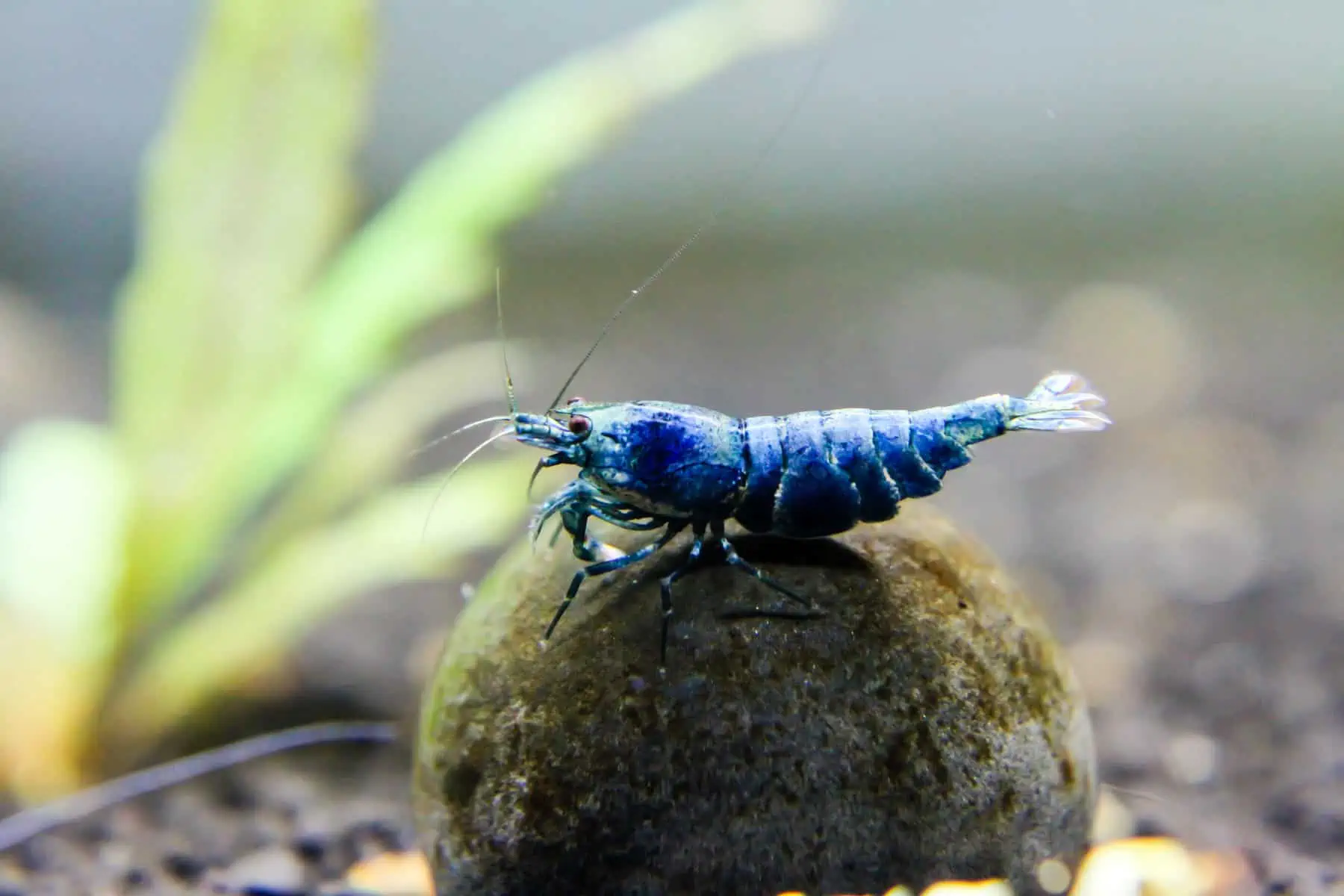
- Scientific Name: Caridina cf. cantonensis var. ‘Blue bolt’
- Care Level: Moderate
- Size: 1 to 1.5 inches
- Minimum tank size: 5 gallons
- Temperature Range: 65 to 75°F/18 to 24°C
- Suggested pH: 6.0 to 7.5
If you’re looking for a unique and unusual variety of shrimp for your aquarium, look no further.
Blue Bolts are one of the most beautiful species out there. Unsurprisingly, though, Blue Bolts are relatively rare and can be hard to find at local fish stores. If you plan to keep this species, you’re best off ordering online.
Blue Bolt Shrimp are another species of Cantonensis (aka Bee Shrimp), so their care requirements are quite similar to those of tiger shrimp.
That being said, they are especially sensitive to ammonia, nitrites, and nitrates, so regular water changes are a must. They also prefer slightly acidic and soft water if you’re looking to get a bit more technical.
Since Cantonensis species often interbreed, you probably shouldn’t keep Blue Bolts with the other species of shrimp on our list unless you know what you’re doing (this goes for most shrimp in general).
Luckily, though, a Blue Bolt species-only tank usually doesn’t need any help in the looks department. Their unique color patterns provide enough variety, especially against the green of a planted tank.
You can buy your Blue Bolt Shrimp online here!
Ghost Shrimp (Palaemonetes sp.)
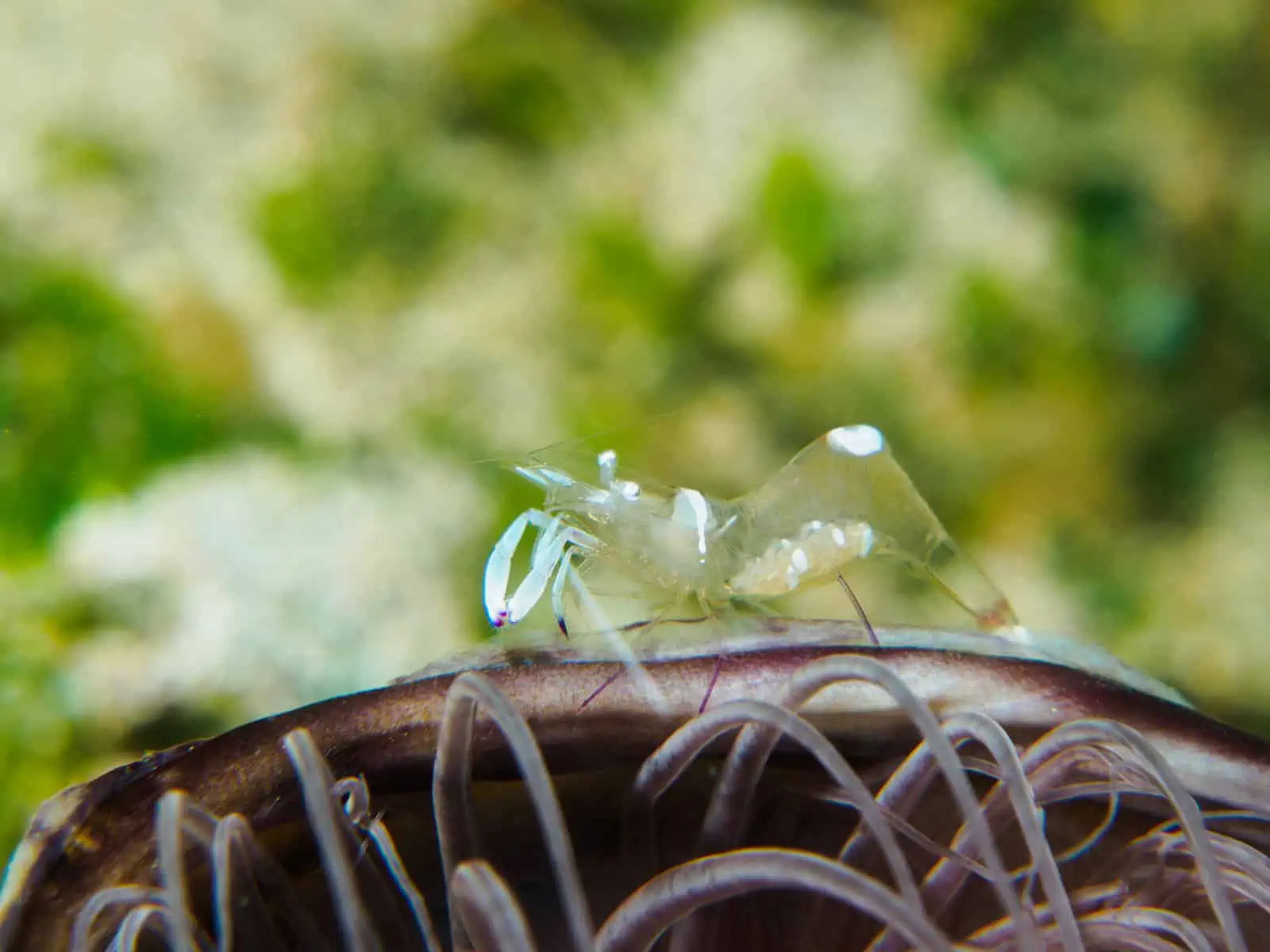
- Scientific Name: Palaemonetes sp.
- Care Level: Easy
- Size: 1.5 inch
- Minimum tank size: 5 gallons
- Temperature Range: 70 to 80°F/21 to 26.5°C
- Suggested pH: 7.0 to 7.8
Ghost Shrimp are, without a doubt, the easiest type of shrimp on our list to care for. They are extremely cheap/common and are generally thought of as feeders rather than pets.
That being said, Ghost Shrimp (sometimes referred to as Glass shrimp) are a great species for first-time shrimp owners.
If you’re looking to set up a nice shrimp-only tank but have never actually kept shrimp before, pick up a few Ghosts to test out your new setup!
Ghost Shrimp are also known for being great scavengers, making them a great addition to community aquariums without aggressive fish. Those that don’t get eaten will scavenge the tank floor for uneaten food, algae, and detritus.
Breeding Ghost Shrimp is a little different than other species on our list. Unlike dwarf shrimp that hatch as miniature versions of the adults, Ghost Shrimp hatch as larvae.
This means they are much more delicate and vulnerable at birth than other species. That being said, the larvae shouldn’t have any problem surviving in a shrimp-only tank.
Click here to buy your ghost shrimp at The Shrimp Farm!
Crystal Red/Crystal Black Shrimp (Caridina cf. Cantonensis)
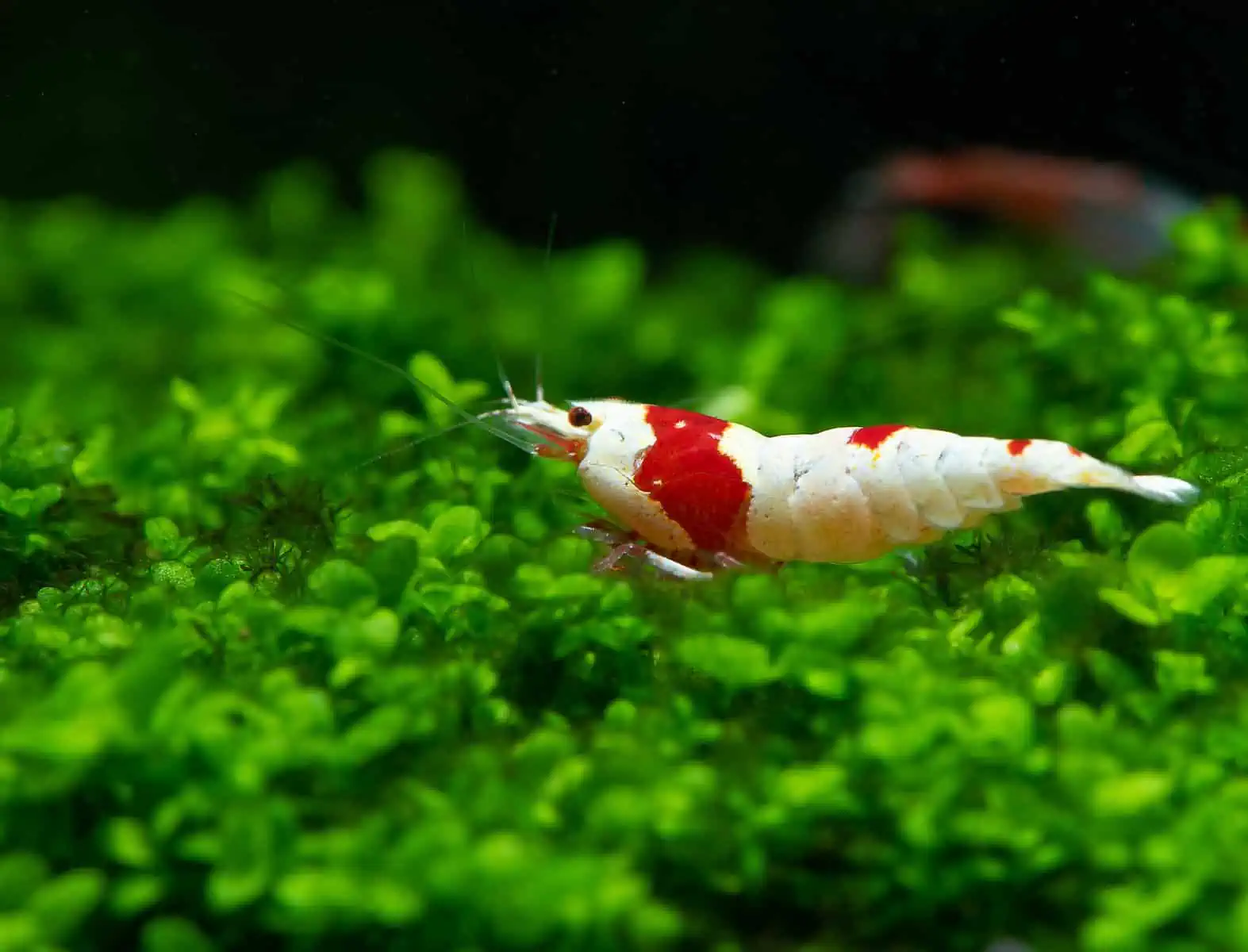
- Scientific Name: Caridina cf. cantonensis var. ‘Crystal Red’
- Care Level: Moderate
- Size: 1 to 1.5 inches
- Minimum tank size: 5 gallons
- Temperature Range: 65 to 75°F/18 to 24°C
- Suggested pH: 6.0 to 7.5
Crystal Red Shrimp (often referred to simply as CRS) is one of the most selectively bred species in the aquarium world.
Over the last few years, demand for this species has exploded, and experts have bred Crystal Reds into stunning and unique patterns, many of which can fetch high prices.
The price of Crystal Red Shrimp is largely based on where they fall on the grading scale, which is as follows – SSS, SS, S+, S, A, B, C. Crystal Red Shrimp with an SSS grade are considered the most desirable and can fetch upwards of $20 each.
Generally, higher-grade CRS is more white and opaque in color than lower grades. You can find an example of a high-grade Crystal Red Shrimp pictured at the top of this article.
For those looking to set up a shrimp-only tank (and dabble in some breeding), Crystal Red Shrimp is a great choice.
CRS is a little bit harder to keep than Cherry Shrimp, but their beauty and patterns definitely make up for the small increase in difficulty.
Crystal Red species-only tanks are extremely beautiful when done correctly!
You can buy Crystal Red Shrimp online here!
Babaulti Shrimp (Caridina Babaulti)
- Scientific Name: Caridina cf. babaulti
- Care Level: Easy
- Size: 1 inch
- Minimum tank size: 5 gallons
- Temperature Range: 65 to 85°F/18 to 29.5°C
- Suggested pH: 6.5 to 7.8
Of all the species on our list, Babaulti Shrimp is probably the most underappreciated. They come in a wide variety of colors, including red, yellow, green, and brown.
In addition, striped varieties are also very common! Despite their range of colors, Babaulti is often overshadowed by more common species such as Crystal Reds or Cherry Shrimp.
Compared to a lot of other dwarf shrimp species, Babaulti is actually pretty easy to care for. The basic necessities of any aquarium (complete cycle, no ammonia/nitrites, stable temp./pH) are still required, of course, but Babaulti is much more accepting of small mistakes.
The omnivorous diet of Caridina babaulti is pretty similar to most dwarf shrimp species. This means a combination of planted based and meat-based food is usually the best option.
That being said, Babaulti has an exceptionally large appetite for decaying plant matter, making them a great choice for planted tanks. They do a great job of getting to dead plants before decomposition occurs.
This helps reduce dissolved organics and toxins such as ammonia, nitrite, and nitrate. Indian almond leaves will be appreciated.
Panda Shrimp (Caridina Cantonensis var. ‘Panda’)
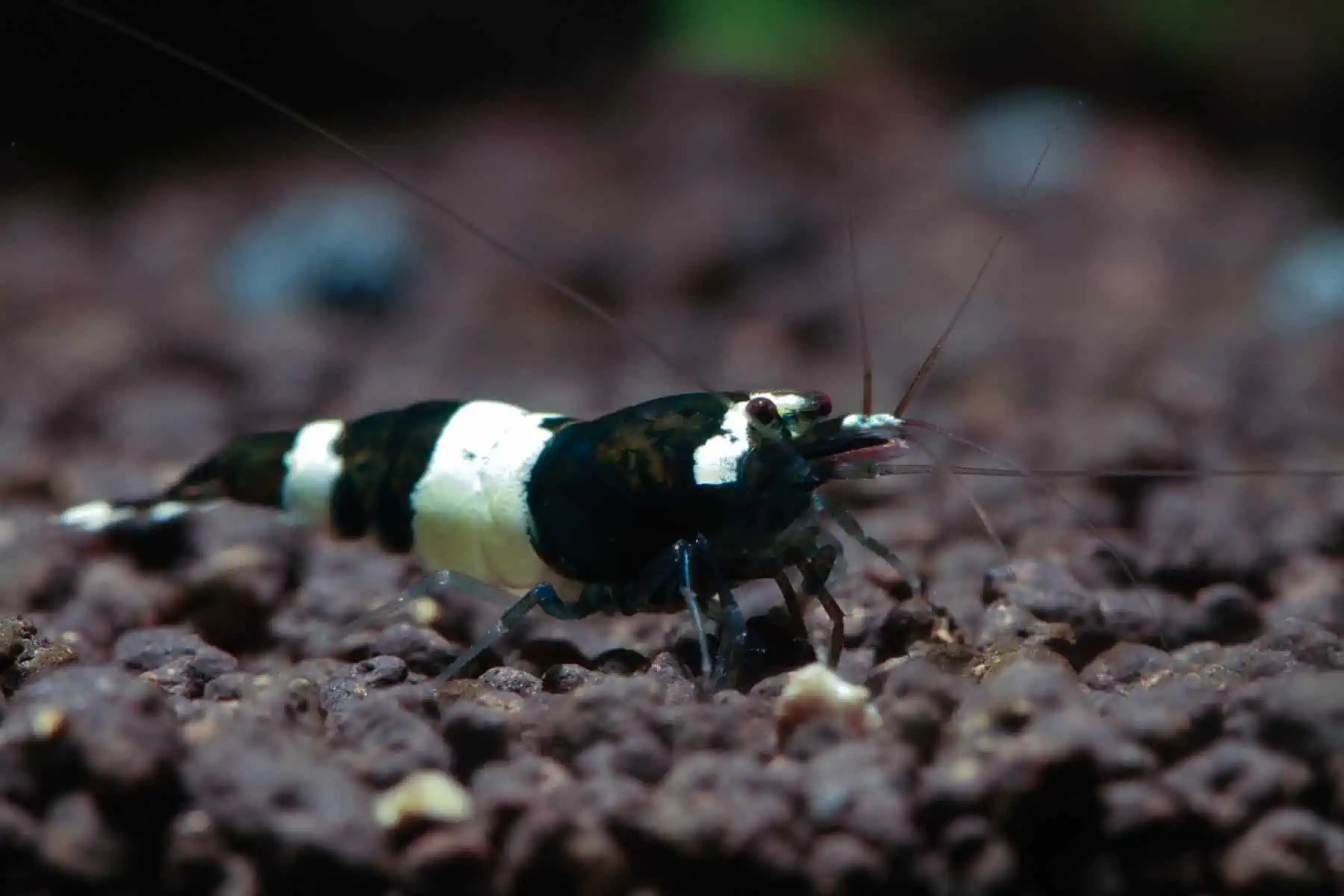
- Scientific Name: Caridina cf. cantonensis var. “Panda”
- Care Level: Semi-difficult
- Size: 1 to 1.5 inches
- Minimum tank size: 5 gallons
- Temperature Range: 62 to 75°F/16.5 to 24.5°C
- Suggested pH: 6.0 to 7.5
Surprise, surprise… another Caridina cantonensis variety makes the list!
Panda Shrimp, also known as Black King Kong Pandas, is a striking black-and-white variety of Cantonensis with an extremely interesting background.
At one point, Black King Kongs were the most “hyped up” dwarf shrimp in the hobby and could fetch hundreds of dollars each. In fact, one sold for the astounding price of $830 to a collector in Japan.
Since then, the craze has definitely died down. Panda Shrimp generally go for $10-$20 each in today’s market. That being said, they are still a great option for aquarists looking for something a little more exclusive than other species on our list.
Although Black Panda Shrimp are a variety of Cantonensis, they are considerably harder to keep than their Crystal Red/Black counterparts.
They are especially sensitive to changes in water conditions, so it is recommended to keep this species in a larger tank to avoid any parameter swings. In addition, Pandas are slower breeders than other varieties of Cantonensis.
If you’re looking to build a quick, easy colony, Pandas probably aren’t the best choice.
You can buy your Black Panda Shrimp online here!
Snowball Shrimp (Neocaridina cf Zhangjiajiensis var. White)
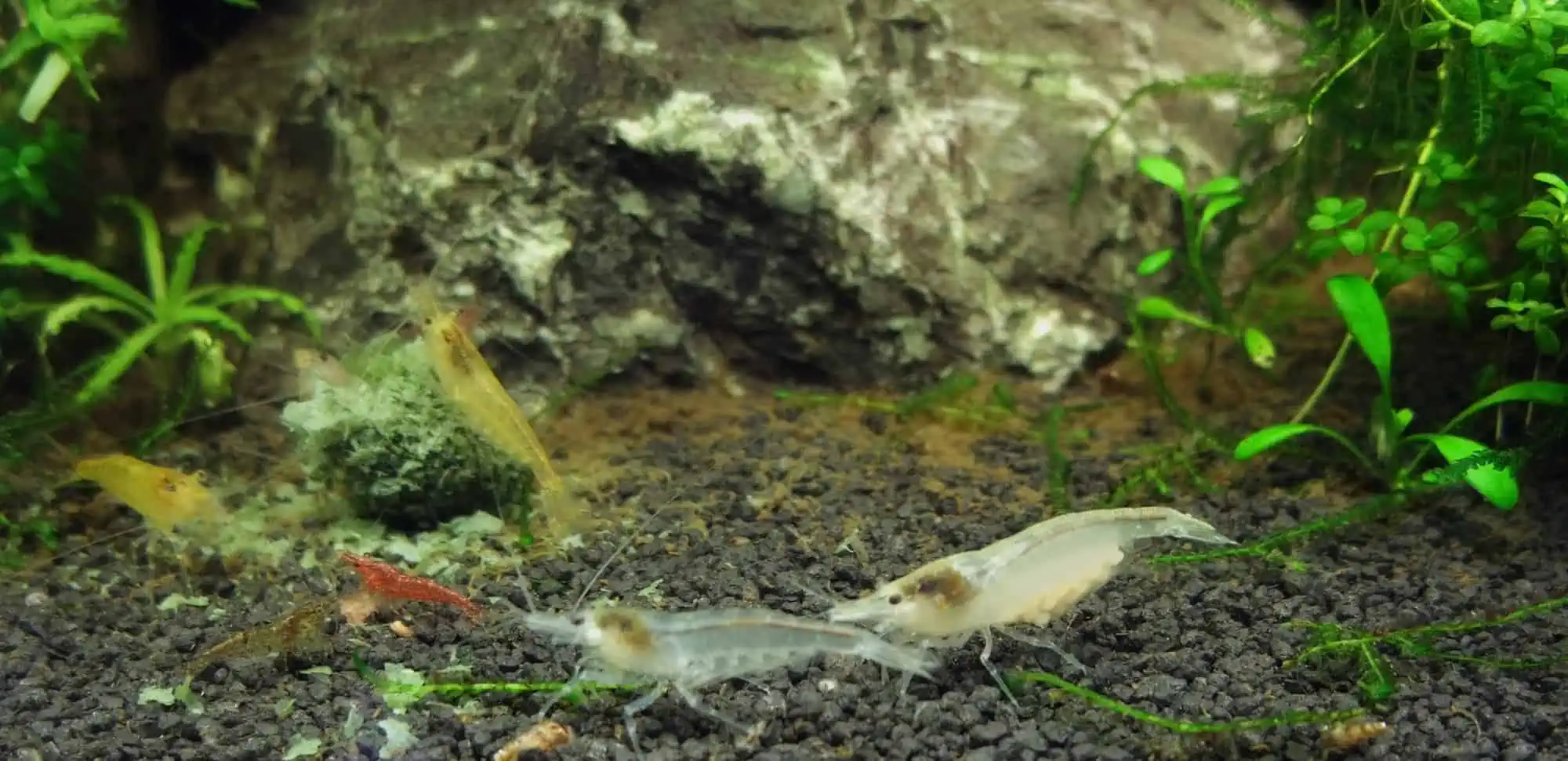
- Scientific Name: Neocaridina cf zhangjiajiensis var. White
- Care Level: Easy
- Size: 1.25 inches
- Minimum tank size: 5 gallons
- Temperature Range: 65 to 85°F/18 to 29.5°C
- Suggested pH: 6.2 to 7.8
For beginner aquarists looking to set up their first shrimp tank (or anyone looking for an easy shrimp to care for), Snowball Shrimp definitely tops the list.
This variety of Neocaridina is easy to care for, striking in appearance, and doesn’t require large/elaborate setups.
Like their Cherry Shrimp cousins, Snowballs aren’t too tough to please when it comes to water conditions, making them a great choice for beginners.
They can tolerate more fluctuations than other species (although you should still try to keep your tank as stable as possible) and can thrive in a wide range of conditions.
In addition to being easy to care for, Snowball Shrimp are also very easy to breed and can multiply into a large colony in no time.
Snowball Shrimp aren’t picky eaters. They survive mostly off detritus and algae. In a clean aquarium, though, the occasional supplemental feeding is necessary.
As we suggested with Red Cherry Shrimp, GlasGarten Shrimp Dinner is a great choice to keep your Snowballs happy and healthy.
Amano Shrimp (Caridina Multidentata)
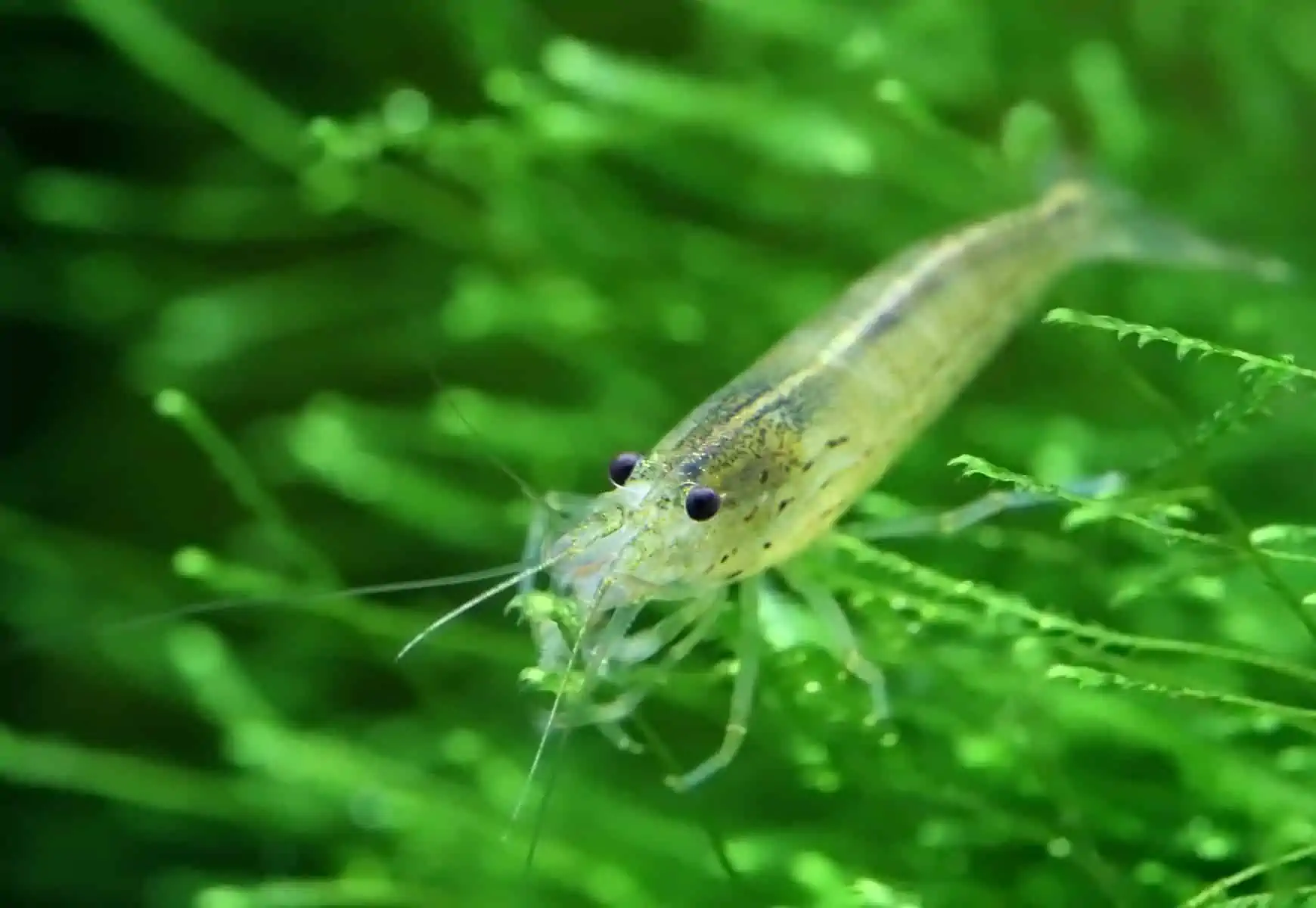
- Scientific Name: Caridina multidentata
- Care Level: Easy
- Size: 2 inches
- Minimum tank size: 10 gallons
- Temperature Range: 65 to 85°F/18 to 29.5°C
- Suggested pH: 6.5 to 8.0
No proper shrimp list would be complete without the famous Amano Shrimp.
Amanos are known for their insatiable appetite for algae. They are common among aquarists that need a little help keeping their tank clean. This shrimp is not on the list of best algae eaters for nothing!
In addition to being great algae-eaters, Amano Shrimp are one of the easiest species on our list to care for. As long as you keep your parameters stable, these shrimp should be able to survive in a wide range of conditions.
This ease of care, along with their relatively large size (2″ to 3” max length), make Amanos a great choice for community aquariums (as long as no predatory fish are present).
While Amano Shrimp are a great beginner species, they definitely aren’t the best for those looking to build a large colony. Amanos are notoriously hard to breed and raise from fry, as larvae require brackish water to survive.
Want to know more? You can find a full Amano shrimp care sheet here.
Cardinal Shrimp (Caridina Dennerli)
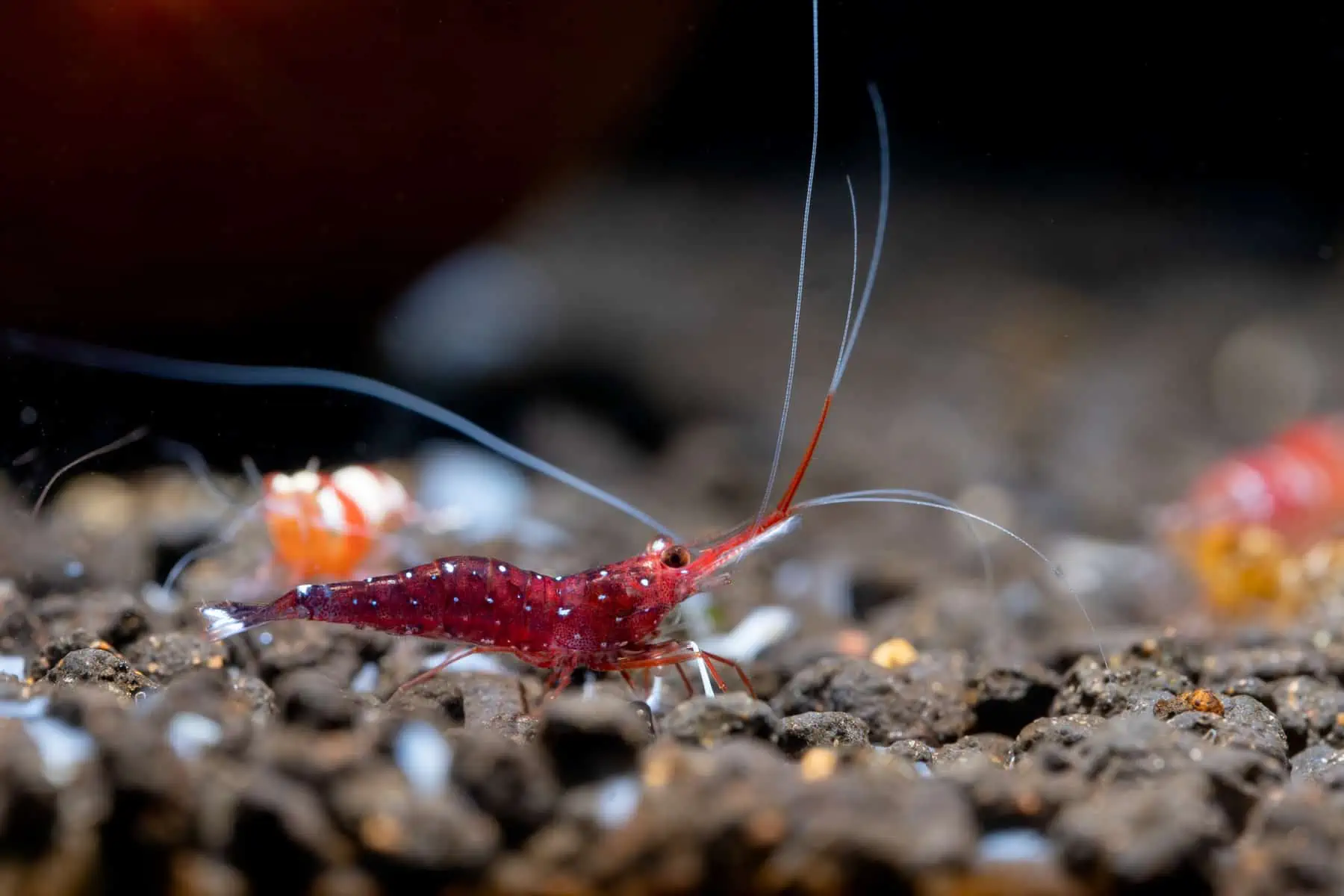
- Scientific Name: Caridina dennerli
- Care Level: Hard
- Size: .5 to 1 inch
- Minimum tank size: 5 gallons
- Temperature Range: 77 to 86°F/25 to 30°C
- Suggested pH: 7.5 to 8.5
Looking for something really special? If you’re an experienced shrimp keeper and up for a challenge, Sulawesi shrimp might be for you.
As their name suggests, these fascinating dwarf shrimp naturally hail from the lakes of Sulawesi, Indonesia.
Sulawesi shrimp are by no means the easiest dwarf shrimp types to keep. In fact, they’re among the most difficult to keep alive! Their amazing colors make them quite desirable, though.
If you want to give it a shot, consider going for Caridina dennerli, also known as the Cardinal shrimp.
Caridina dennerli is the most popular and commonly available of the Sulawesi shrimp, likely because it’s the easiest species to keep. You’ll have to set up a single-species Sulawesi biotope for these amazing red-colored, white-handed critters.
That means hard water with a higher pH, warm water, and as much biofilm as you can possibly cultivate. With a bit of luck, you might even see some offspring!
Orange Pumpkin Shrimp (Neocaridina Heteropoda var. Orange)
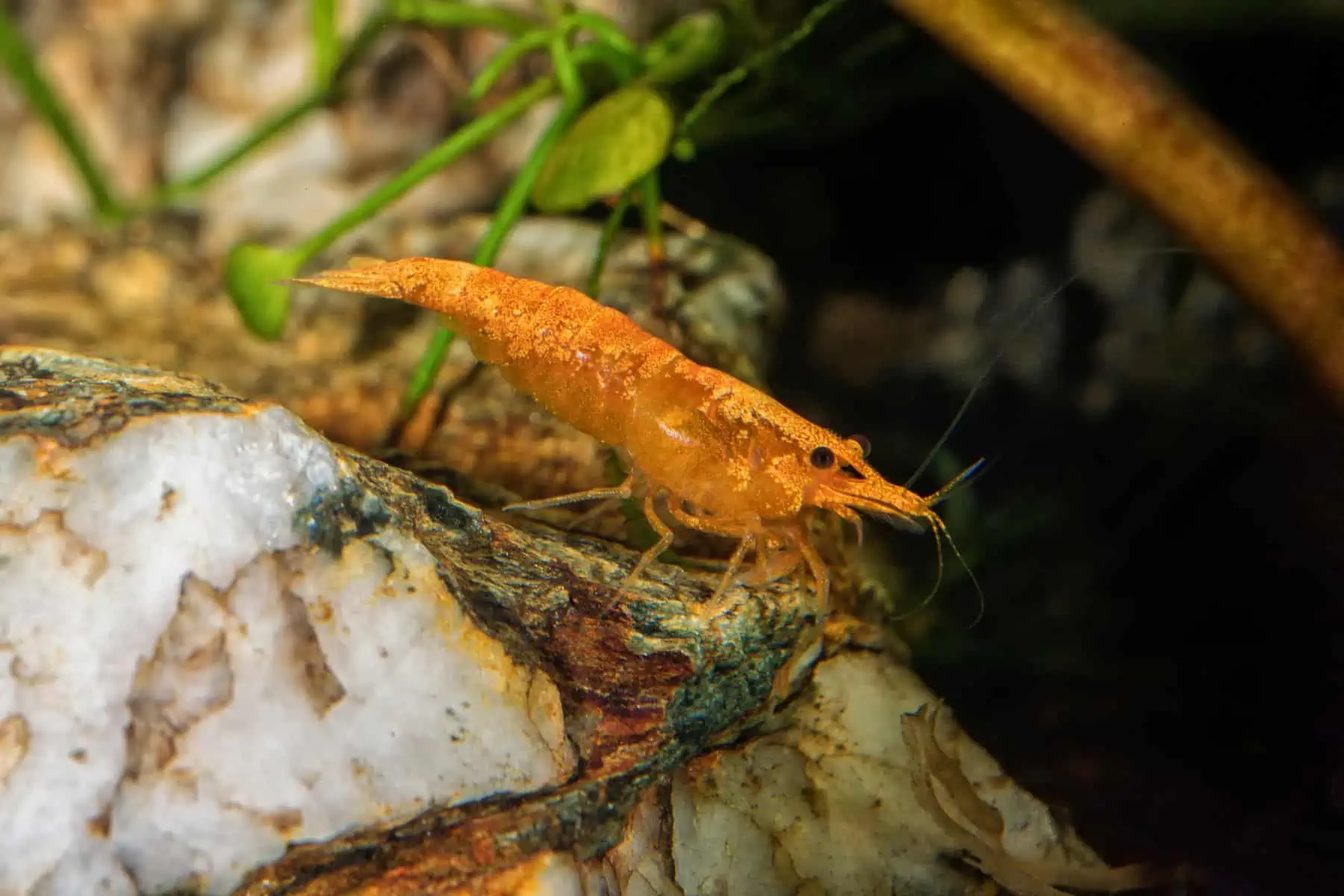
- Scientific Name: Neocaridina heteropoda var. orange
- Care Level: Easy
- Size: 1.5 inches
- Minimum tank size: 5 gallons
- Temperature Range: 65 to 85°F/18.3 to 29.4°C
- Suggested pH: 6.2 to 7.8
Orange Pumpkin shrimp are a vibrant orange color that adds a beautiful extra dimension to any freshwater setup. These pretty little shrimp are easy to care for, too, making them an ideal choice for beginners to the shrimp-keeping hobby.
Like many other shrimp species, the Orange Pumpkin shrimp feeds on algae, detritus, and scraps of uneaten fish food.
The shrimp aren’t fussy when it comes to water conditions, and they can coexist happily with other small shrimp species, snails, and fish that won’t try to eat them.
You don’t need to worry that the shrimp’s lifespan is relatively short since these critters are prolific breeders, giving birth to fully-formed shrimplets every few weeks.
Bumblebee Shrimp (Caridina cf. Breviata)
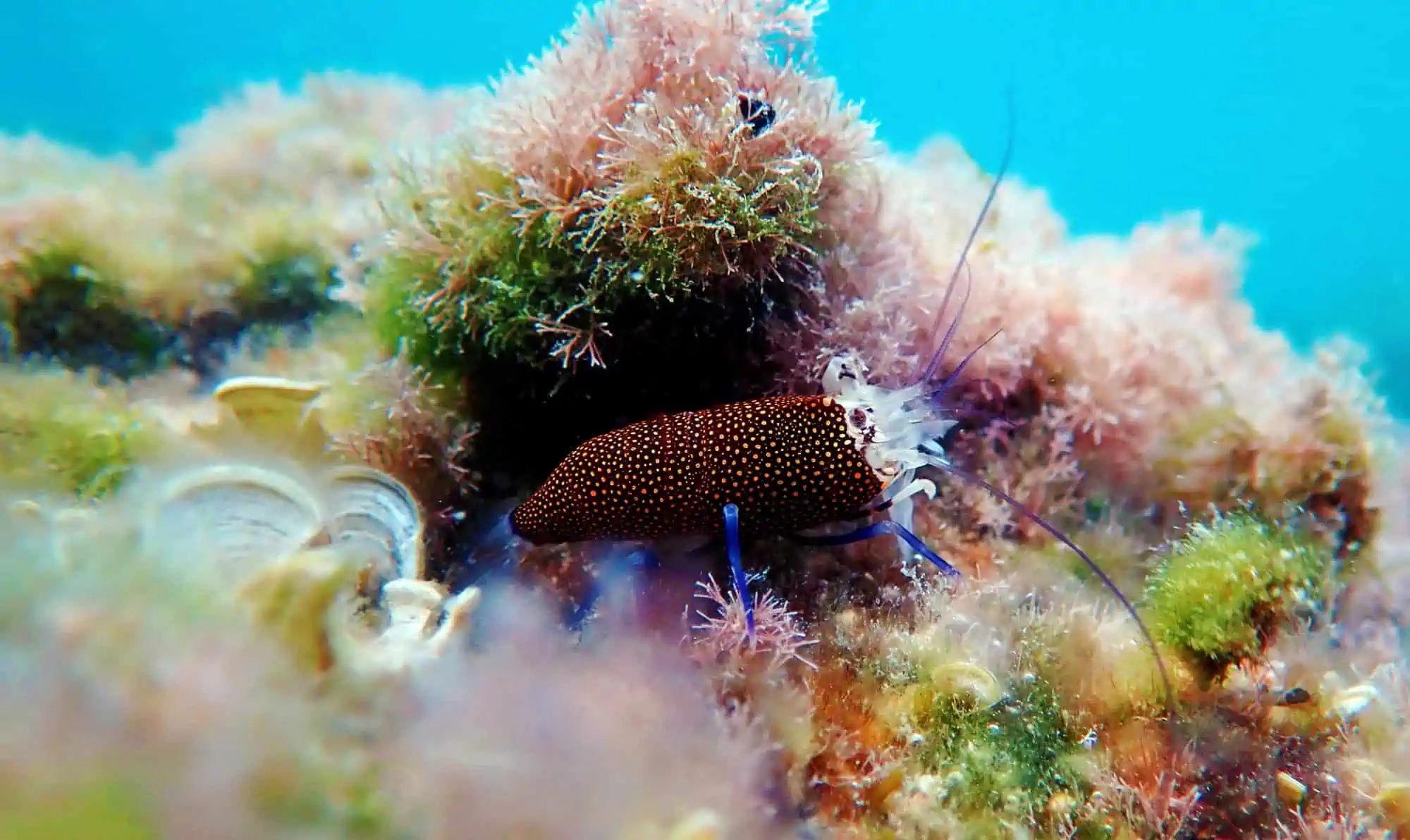
- Scientific Name: Caridina cf. breviata
- Care Level: Moderate
- Size: 1 inch
- Minimum tank size: 5 gallons
- Temperature Range: 70 to 80°F/21 to 26.5°C
- Suggested pH: 6.0 to 7.2
Bumblebee Shrimp is a species of dwarf shrimp named after their striped coloration. While they’re not the hardest species to care for, Bumblebees are sensitive to ammonia and nitrites and should only be kept in pristine conditions.
Despite the confusing name, Bumblebee Shrimp are not a type of Bee Shrimp (Caridina cf. cantonensis) but an entirely different species.
Many shrimp owners like to keep Bumblebees with Red Cherry Shrimp, as the two require similar water parameters and will not interbreed.
If you have any questions about the shrimp species on this list or want to share your own experiences with keeping and breeding aquarium shrimp, don’t hesitate to leave a comment below!
Bamboo Shrimp (Atyopsis Moluccensis)
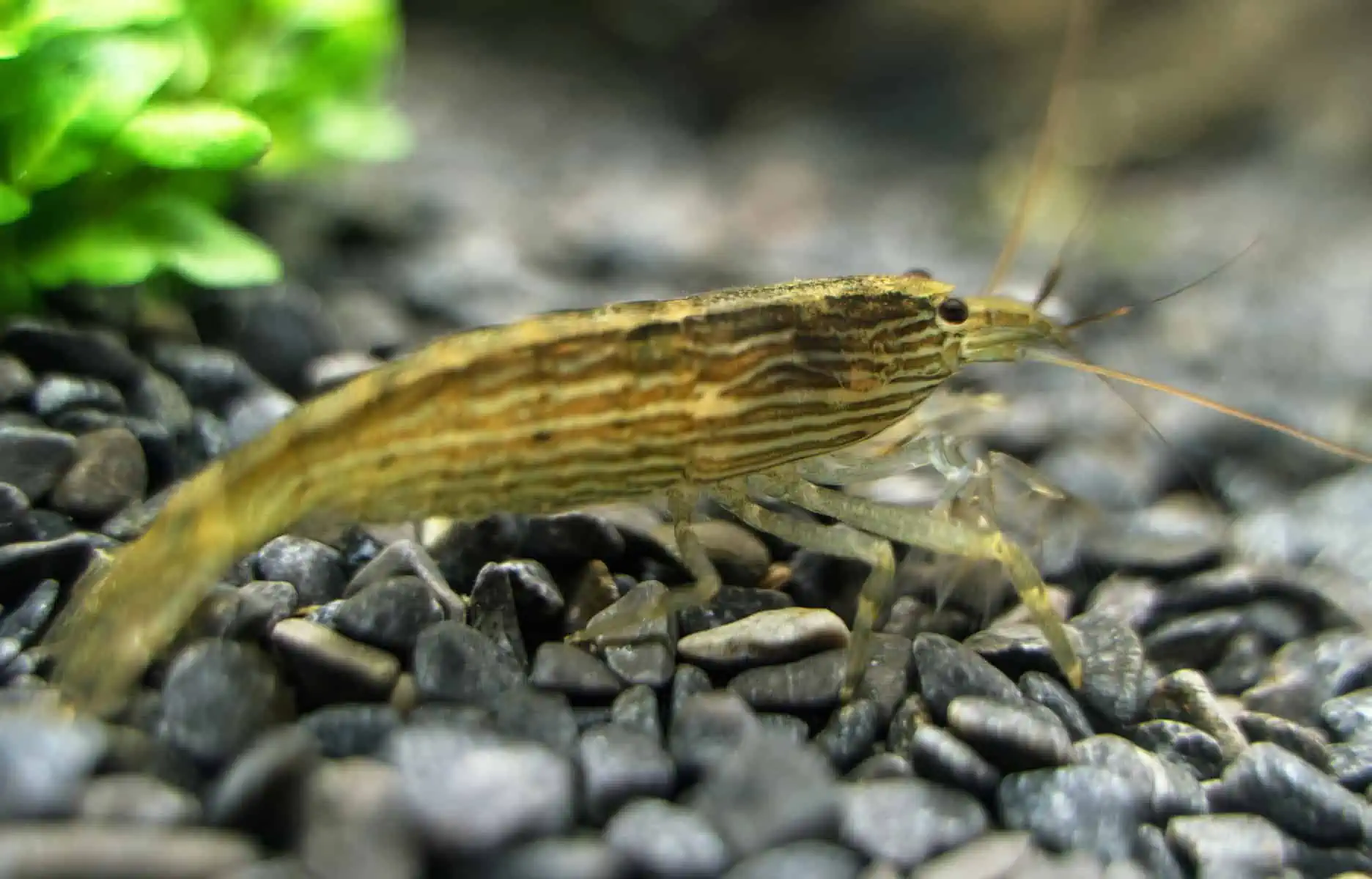
- Scientific Name: Atyopsis moluccensis
- Care Level: Moderate
- Size: 2 to 3 inches
- Minimum tank size: 10 gallons
- Temperature Range: 75 to 81°F/21 to 27°C
- Suggested pH: 7.0 to 7.5
Bamboo shrimp are native to India, Sri Lanka, the Samoan Islands, and Southeast Asia.
These shrimp lack the brilliant colors of some of the other species we’ve mentioned in this guide. However, they are fascinating critters to watch in your aquarium!
Bamboo shrimp are unusual because they are filter-feeders with fan-like structures. instead of the claws that you see on most other shrimp species.
The shrimp choose a spot in the aquarium with a moderate to strong flow and cling to a piece of driftwood or rock. As the water flows over the shrimp, it carries with it tiny fragments of food, which the shrimp catch in their filter ‘net.’
These amazing shrimp have a lifespan of around two years and are pretty much impossible to breed in the home tank.
Golden Bee Shrimp (Caridina cf. Cantonensis)
- Scientific Name: Cardina cf. cantonensis
- Care Level: Intermediate
- Size: 1.2 inches
- Minimum tank size: 10 gallons
- Temperature Range: 62 to 76°F/16.6 to 24.4°C
- Suggested pH: 5.8 to 7.4
The Golden Bee shrimp has orange-pink flesh covered in snow-white skin, giving this gorgeous invert a beautiful golden color.
This unusual species of freshwater shrimp is seldom seen in fish stores, although you can sometimes buy them online. It’s best to keep Bee shrimp in a single-species aquarium setup or with a few nano fish that won’t be tempted to attempt to eat the shrimp.
If you decide to have a go at keeping Golden Bee shrimp, don’t clean your tank of all algae and biofilm since that forms a major part of the shrimp’s diet.
Blue Velvet Shrimp (Neocaridina Davidi var.)
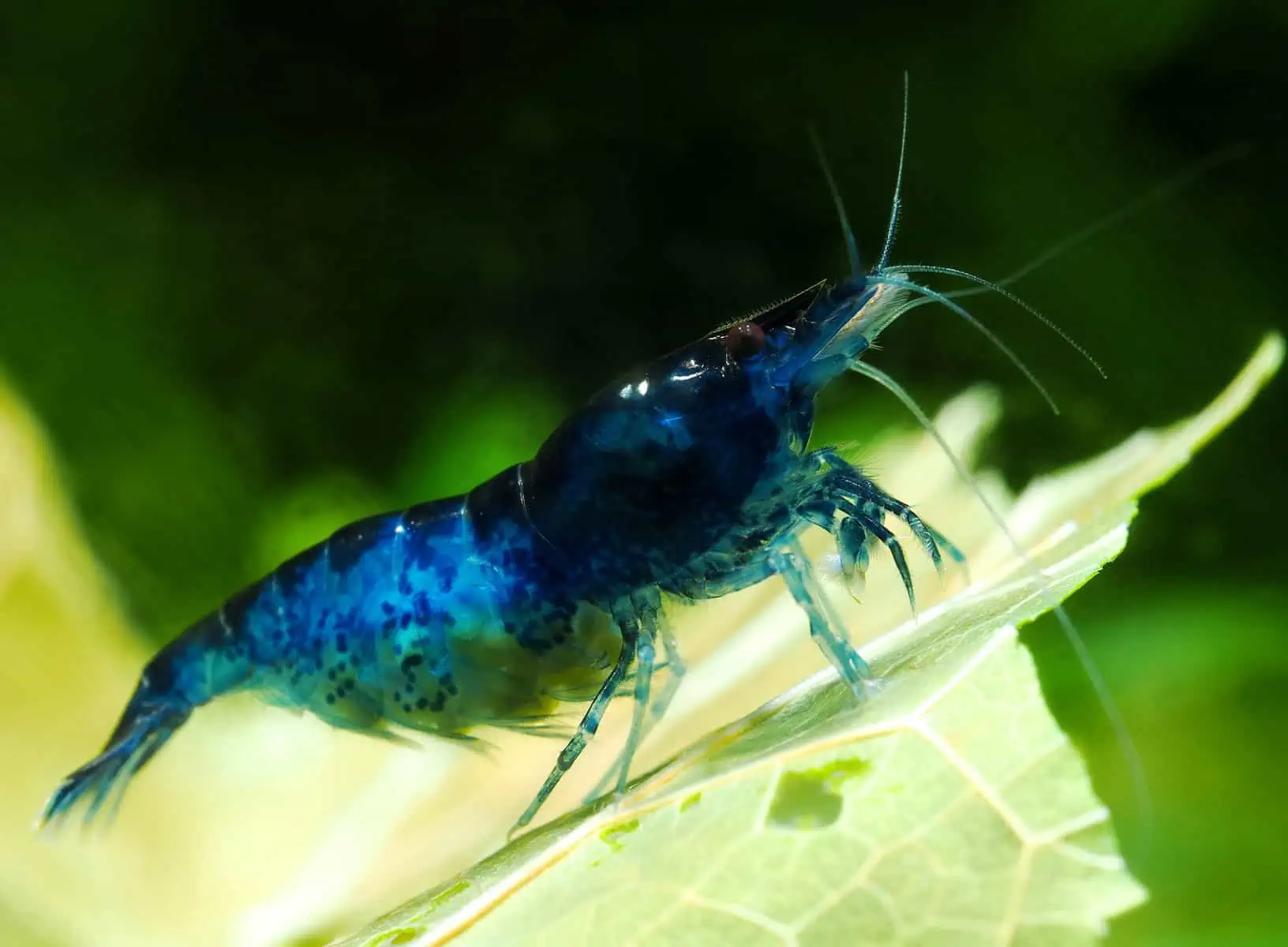
- Scientific Name: Neocaridina davidi var.
- Care Level: Easy
- Size: 2 inches
- Minimum tank size: 10 gallons
- Temperature Range: 72 to 82°F/22 to 27.7°C
- Suggested pH: 6.8 to 7.5
Blue Velvet shrimp are a variation of the Cherry shrimp mentioned earlier in this guide.
This beautiful blue shrimp makes an excellent pet for children, being easy to care for and able to live in a well-maintained nano tank. These little shrimp also reproduce readily, making breeding the Blue Velvet shrimp a fascinating project for beginners.
The shrimp make a helpful addition to a community tank, grazing on scraps of food, detritus, and algae, helping to improve the water quality in the aquarium and keep it looking tidy.
Blue Velvet shrimp live happily in an invertebrate tank with snails and other shrimp species. However, you can keep them in a regular community aquarium with peaceful fish that won’t try to eat the shrimp.
Pinto Shrimp (Caridina Cantonensis Pinto Bee)
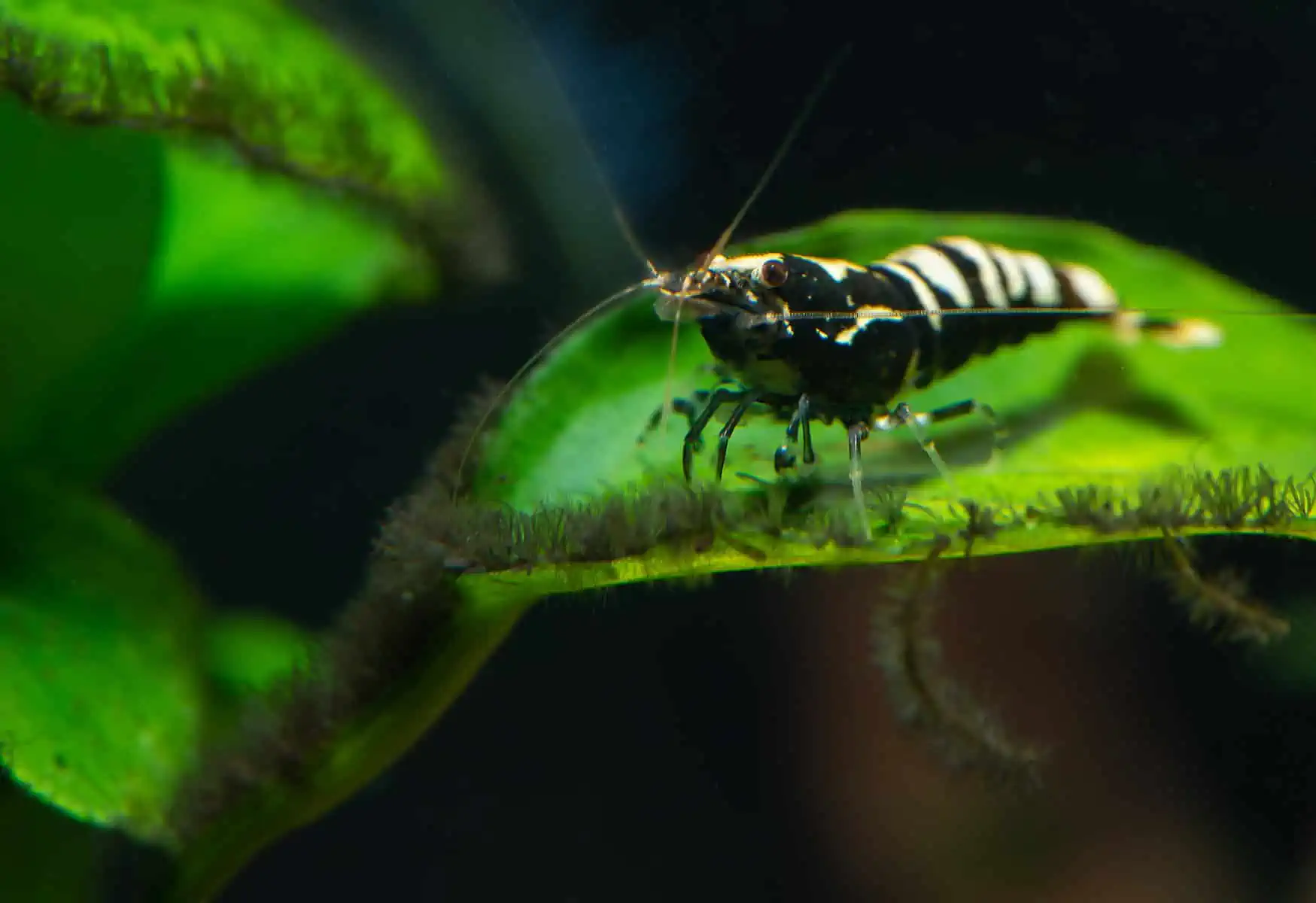
- Scientific Name: Caridina cantonensis Pinto Bee
- Care Level: Intermediate
- Size: 1 to 1.5 inches
- Minimum tank size: 10 gallons
- Temperature Range: 62 to 76°F/16.6 to 24.4°C
- Suggested pH: 5.8 to 7.4
Pinto shrimp are gorgeous little creatures that are not generally seen in fish stores. That’s because the shrimp are expensive to buy and difficult to keep.
Unfortunately, Pinto shrimp are heavily selectively bred, which makes them highly sensitive to unstable water conditions.
These shrimp are also fussy about water chemistry, so you’ll need to provide them with the perfect conditions if they are to survive and thrive.
Many expert shrimp keepers use RO (Reverse Osmosis) water together with a pH-lowering substrate. That way, you can create the ideal water chemistry for the shrimp and be sure that your aquarium water is free from toxins.
Blue Pearl Shrimp (Neocaridina cf. Zhangjiajiensis var. Blue)
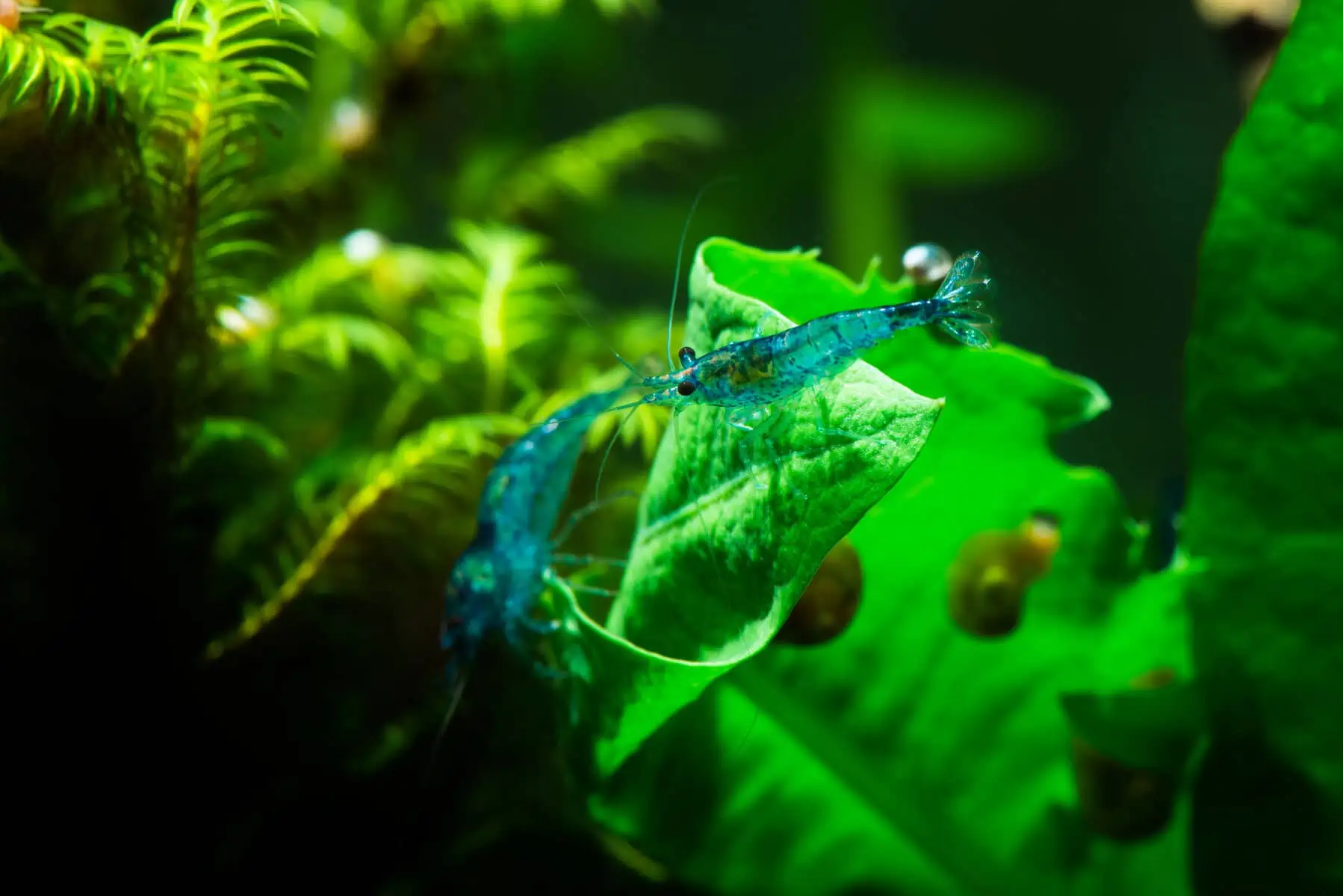
- Scientific Name: Neocaridina cf. Zhangjiajiensis var. Blue
- Care Level: Easy
- Size: 1 to 1.2 inches
- Minimum tank size: 10 gallons
- Temperature Range: 60 to 85°F/15.5 to 29.4°C
- Suggested pH: 6.5 to 8.0
Blue Pearl shrimp make a great choice for beginners, as they are attractive and easy to keep.
This freshwater shrimp species is relatively new to the hobby, having been created in Germany by breeding from wild Neocaridina cf. zhangjiajiensis.
Blue Pearl shrimp first appeared in home aquariums in around 2007 and have quickly gained popularity thanks to their ease of care and hardy nature.
Blue Pearl shrimp come in a range of colors, from white to pale, pearlescent blue. Interestingly, female shrimp are usually more colorful than males. The shrimp’s color is greatly influenced by genetics and the water quality in the tank.
Chocolate Shrimp (Neocaridina Davidi)
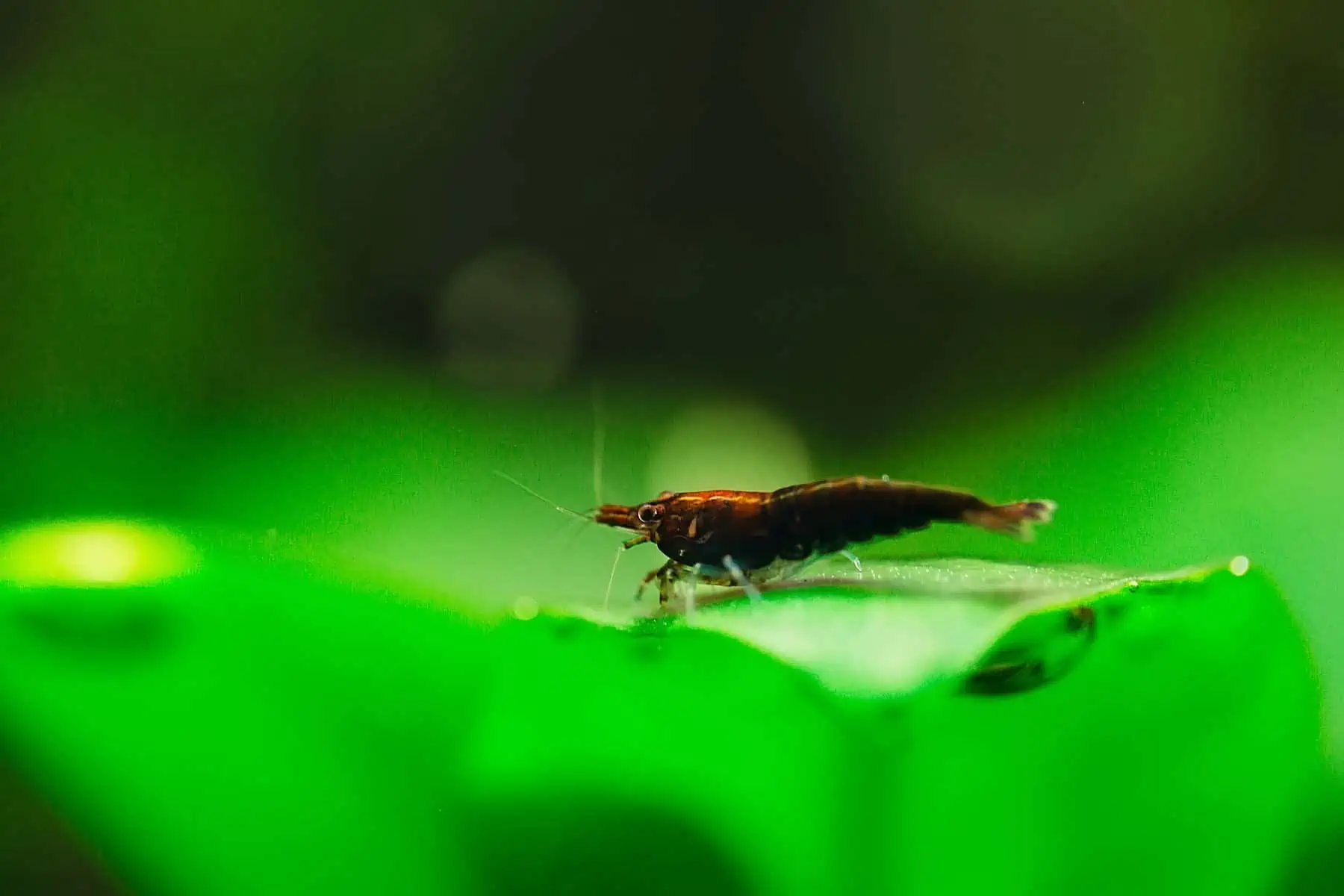
- Scientific Name: Neocaridina davidi
- Care Level: Easy
- Size: 1.5 inches
- Minimum tank size: 5 gallons
- Temperature Range: 65 to 85°F/18.3 to 29.4°C
- Suggested pH: 6.5 to 8.0
The Chocolate shrimp is a variant of the ever-popular Cherry shrimp and can be any color from brown to black.
These shrimp are prolific breeders and will readily interbreed with their own species. That’s all very well but can lead to dilution of the shrimps’ colors so that you could end up with a tank full of drab brownish-colored critters rather than a mix of red, chocolate, and blue.
Chocolate shrimp help to keep the tank tidy by scavenging on algae, uneaten fish food, and detritus.
Indian Whisker Shrimp (Macrobrachium Lamarrei)
- Scientific Name: Macrobrachium lamarrei
- Care Level: Difficult
- Size: 2 inches
- Minimum tank size: 10 gallons
- Temperature Range: 72 to 82°F/22.2 to 27.7°C
- Suggested pH: 7.0 to 7.8
Indian Whisker shrimp are often confused with Ghost shrimp, largely thanks to their transparent appearance.
However, Indian Whisker shrimp are extremely aggressive, both toward other invertebrates, small fish, and each other. That said, provided you have a large, well-decorated tank that’s not overcrowded, the shrimp can usually tolerate each other.
Indian Whisker shrimp are large creatures that are fussy when it comes to water chemistry and tank cleanliness, making them challenging to keep healthy.
However, the shrimp will scavenge on detritus and leftover fish food, and they will happily eat most commercially prepared shrimp food, too.
Red Rili Shrimp (Neocaridina Davidi)
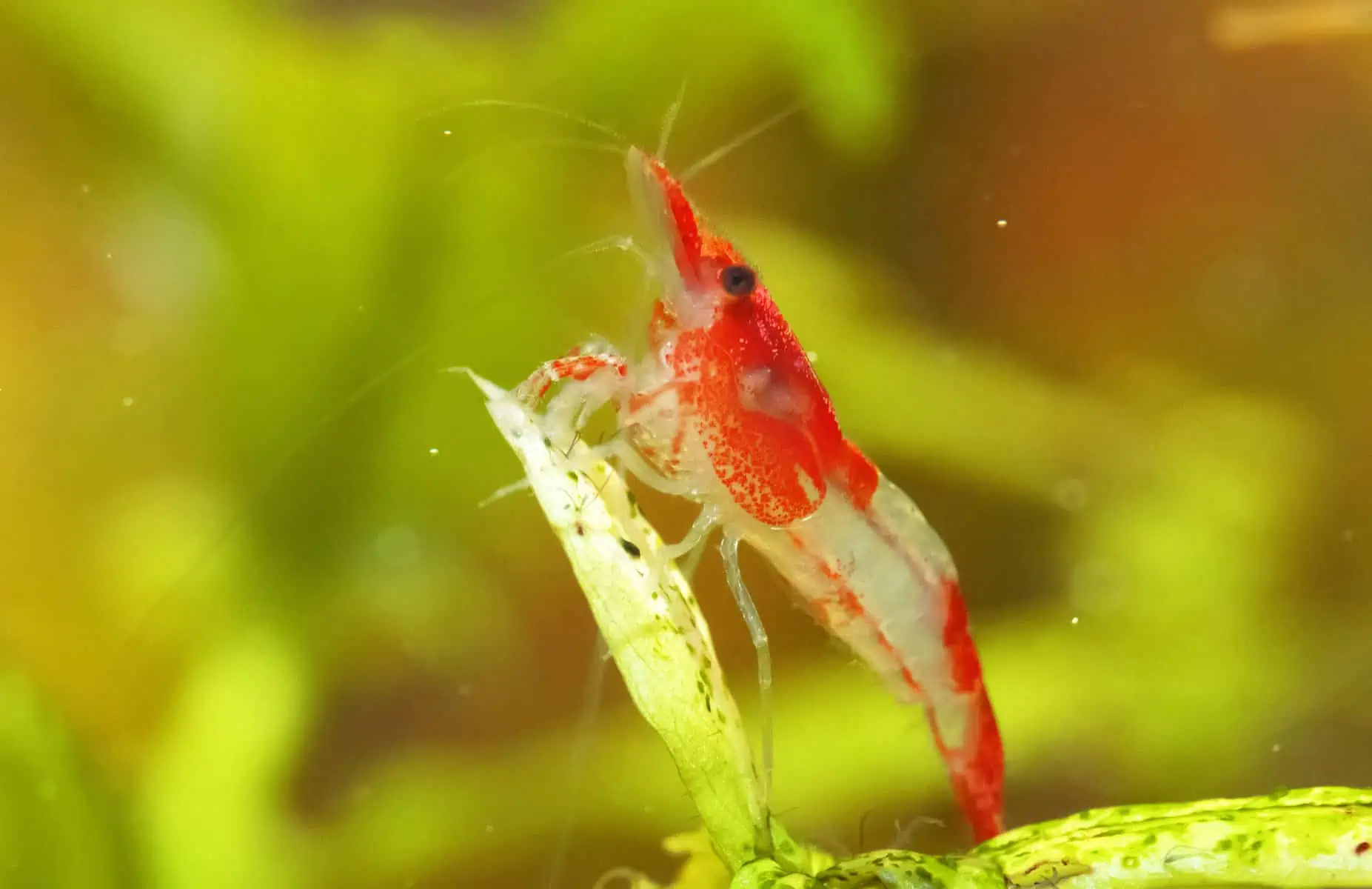
- Scientific Name: Neocaridina davidi
- Care Level: Easy
- Size: 1 to 1.5 inches
- Minimum tank size: 5 gallons
- Temperature Range: 65 to 85°F/18.3 to 29.4°C
- Suggested pH: 6.2 to 8.0
The Red Rili shrimp is a gorgeous little invertebrate created through selective breeding from Red Cherry shrimp. These delightful shrimp are bright red with translucent patches across their bodies.
Rili shrimp are extremely easy to care for, and they’re peaceful creatures that can live in a community tank. These shrimp help to keep the tank tidy by eating algae, scraps of fish food, and general detritus.
This shrimp species is inexpensive to buy and pretty readily available in pet stores. In addition, the Red Rili shrimp is a prolific breeder that does well in a nano tank.
Snowball Shrimp (Neocaridina cf. Zhangjiajiensis)
- Scientific Name: Neocaridina cf. zhangjiajiensis
- Care Level: Easy
- Size: 1.25 inches
- Minimum tank size: 5 gallons
- Temperature Range: 68 to 72°F/20.0 to 22.2°C
- Suggested pH: 7.0 to 7.4
Snowball shrimp are a white color morph of the popular Neocaridina cf. zhangjiajiensis species. These tiny shrimp are easy to care for and hardy, making them an ideal tank mate for Cherry shrimp. You can easily breed Snowball shrimp in your home tank, too.
These shrimp get their common name from the starkly white eggs they produce that look just like snowballs!
Snowball shrimp feed on algae and detritus. However, you can supplement the shrimp’s diet with algae wafers and shrimp pellets.
Vampire Shrimp (Atya Gabonensis)
- Scientific Name: Atya Gabonensis
- Care Level: Intermediate
- Size: up to 6 inches
- Minimum tank size: 20 gallons
- Temperature Range: 75 to 84°F/23.8 to 28.8°C
- Suggested pH: 6.5 to 7.5
Vampire shrimp do not eat other shrimp, despite their somewhat scary common name!
In fact, Vampire shrimp are peaceful filter-feeders that spend most of the daytime hiding away, only emerging under cover of darkness at night to feed.
Vampire shrimp need a strong flow in their aquarium to move tiny food scraps through the water for the shrimp to grab with their net-like fans.
You’ll need to provide these shrimp with lots of food if they are to thrive. So, provide algae wafers and baby shrimp food to supplement the detritus that make up most of the shrimps’ diet.
FAQs
Now, we answer some of the most commonly asked questions about keeping freshwater shrimp.
Q: What Kind of Shrimp Can Be Kept Together?
A: With one or two exceptions, most freshwater shrimp are peaceful creatures that can live happily with other shrimp of a similar size.
However, before you make your choice, research the shrimp carefully to make sure that they share the same water conditions and dietary requirements.
Some species are highly sensitive to water chemistry and temperature and will die if conditions are not ideal.
Q: Which Aquarium Shrimp Are the Hardiest?
A: Just about the hardiest shrimp in the hobby are those varieties within the Neocaridina species, such as Red Cherry shrimp.
These pretty shrimp are generally regarded as the go-to starter shrimp for beginners, as they are easy to care for and extremely hardy.
Q: Are Freshwater Shrimp Easy To Keep?
A: Freshwater shrimp are easier to care for than fish in many respects. However, shrimp are much more sensitive to fluctuations in water conditions.
In addition, shrimp are highly sensitive to copper, iron, and other heavy metals that are found in fish medication and plant fertilizers. Excessive use of such chemicals usually results in mass shrimp kills.
Q: Do Freshwater Shrimp Get Big?
A: Most species of freshwater shrimp don’t grow bigger than an inch or two long. However, a few species, such as the Vampire shrimp (see above), can reach 6 inches in length.
Q: How Long Do Freshwater Shrimp Live?
A: Most species of aquarium shrimp have a short lifespan of a year or two. However, filter-feeding fan shrimp typically live longer, sometimes up to 10 or even 12 years!
Q: Can Aquarium Shrimps Be Kept in the Same Tank as Fish?
A: Generally, you can keep aquarium shrimp with fish, provided that they share the same basic requirements of water chemistry and temperature.
However, many carnivorous or omnivorous fish will regard very small shrimp as a food source. So, be careful to research your fish thoroughly before adding shrimp to your setup.
Q: How Many Shrimps Should I Put In My Aquarium?
A: Dwarf shrimp are tiny creatures that produce a very small bioload. In addition, many shrimp feed on waste and detritus, effectively keeping the tank clean and reducing the strain on your filter system.
So, shrimp can live in more dense populations than fish, although overcrowding should still be avoided. We recommend keeping 10 to 15 dwarf shrimp per five gallons of water.
Final Thoughts
Did you enjoy our guide to some of the many varieties of freshwater shrimp that you can keep in a home tank? If you did, please share the article with other shrimp enthusiasts!
If you have children that want easy-to-care-for, fun pets, freshwater shrimp can be an excellent choice. Kids love to set up shrimp breeding projects, too, making these critters educational, interesting pets.
What species of shrimp do you keep? Tell us about your invertebrate collection in the comments box below.

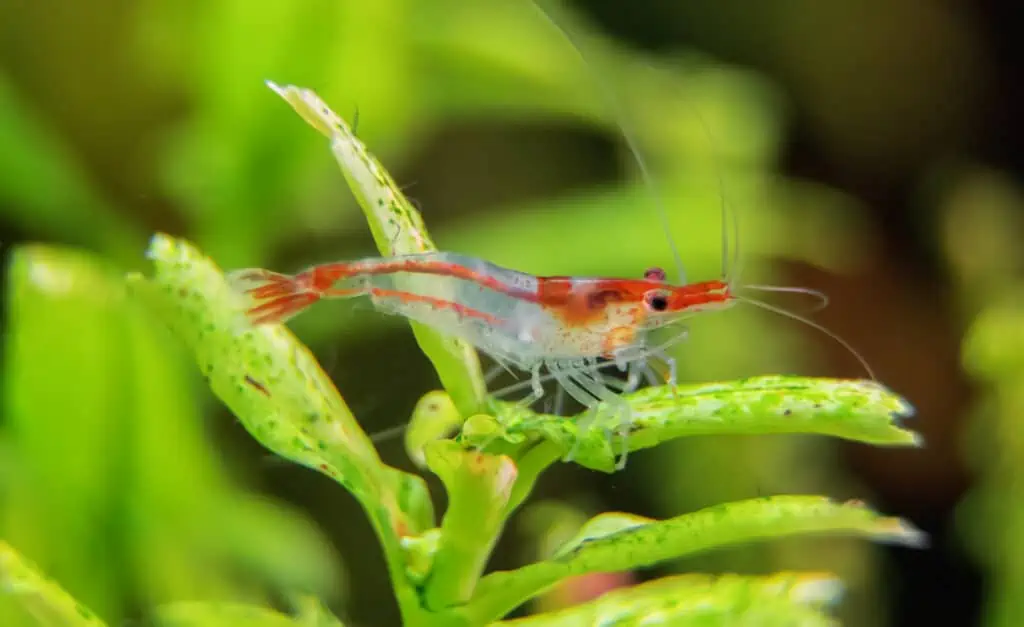

I’m nine and I’m going to get a baby ghost shrimp or a loach which is better?
Hi Sveinn!
There is a big difference between keeping ghost shrimp and keeping loaches. Each of them can be difficult to keep in their own way, and I don’t recommend either until you’ve done enough research and feel confident keeping a stable tank.
If you’re just starting out in the fishkeeping hobby, I would recommend some common guppies or other tropical fish that can tolerate less than perfect water quality.
Hi, I have shrimp in my tank and I wanted to get some more.
But I’m having trouble finding some shrimp.
Can you tell me where I can find some?
Hi Rocio!
I would go to the place where you got your shrimp in the first place; if they’ve lasted this long, then that pet store must be pretty reputable. Otherwise, try to support your local independent fish stores. You can also look online in stores and/or for other hobbyists if nothing seems to be available in your immediate area.
Good luck!
I’m only a kid and I got some shrimp from a pond it said they eat lettuce but they are not eating I do not know the species they are also laying on their side
Hi Isla,
Welcome to the hobby! It is a little concerning that you say the shrimp is on its side. Has it moved since you replied to this post?
More than likely, your freshwater shrimp would eat lettuce, so you’re on the right track! I am just more concerned that something is wrong with the shrimp.
hi, I’m looking to set up a 5 gallon shrimp tank… I have never owned shrimp before, could you give some pointers?
Hi Molly,
Welcome to shrimp-keeping! Shrimp can make all the difference in a small aquarium. In this article, we focus on dwarf shrimp species that could be perfect for your 5 gallon tank.
Happy shrimp-keeping!
My boyfriend bought me a small tropical tank yesterday. I am so excited about the thought of keeping some shrimp in it. They’re just the cutest little things.
We are in the UK, any breeders you’d recommend?
Hi! What a great gift 🙂
For dwarf shrimp if you’re looking for fellow hobbyist keepers/breeders I’d turn to Facebook groups! I don’t know any breeders myself as I’m not located in the UK but I know there are plenty of groups out there that have a wealth of information and make it easier to find breeders. I think the one called “Freshwater Shrimp and Crayfish Keepers” is UK-centered.
Best of luck, hope it all works out! 🙂
happy shrimping!
Happy shrimping to you!
hi,
im thinking about turning a 10 gal into a shrimp tank. do you know any good online shrimp store that ships to canada?
Hey! Yes I do actually, I work closely with The Shrimp Farm, which is a great company that sells homebred shrimp. If you’d like, you can even support Aquariadise by accessing The Shrimp Farm through the banner on this page.
Happy shrimping! 🙂